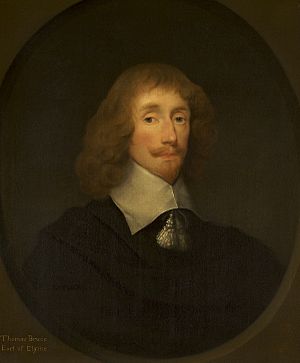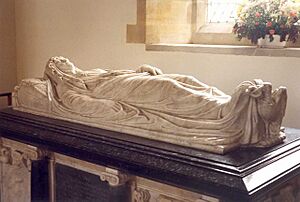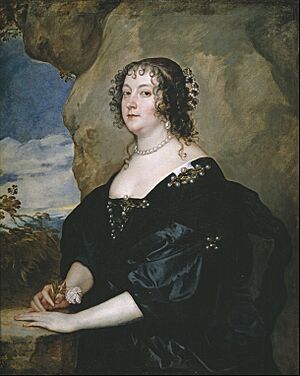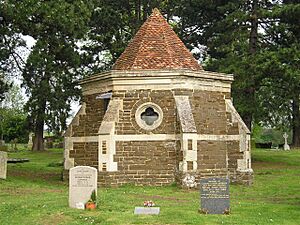Thomas Bruce, 1st Earl of Elgin facts for kids
Quick facts for kids
Thomas Bruce
|
|
|---|---|

Portrait by Cornelius Johnson
|
|
| Born | 2 December 1599 Edinburgh |
| Died | 21 December 1663 (aged 64) |
| Title | Earl of Elgin |
| Other titles | 3rd Lord Kinloss Baron Bruce of Whorlton |
| Nationality | Scottish |
| Residence | Houghton House |
| Spouse(s) | Anne Chichester Lady Diana Cecil |
| Issue | Robert Bruce, 1st Earl of Ailesbury and 2nd Earl of Elgin |
| Parents | Edward Bruce, 1st Lord Kinloss Magdalene Clerk |
|
|
|
Thomas Bruce, 1st Earl of Elgin, was an important Scottish nobleman. He was also known as the 3rd Lord Bruce of Kinloss. Thomas Bruce lived from December 2, 1599, to December 21, 1663. His main home was Houghton House in Maulden, Bedfordshire.
Contents
Early Life and Family
Thomas Bruce was born in Edinburgh in 1599. He was the second son of Edward Bruce, 1st Lord Kinloss and Magdalene Clerk. When he was 13, in August 1613, Thomas became the 3rd Lord Bruce of Kinloss. This happened after his older brother, Edward Bruce, 2nd Lord Kinloss, died in a duel.
The Bruce family owned lands like Whorlton Castle. King James I of England had given these lands to Thomas's father in 1603. When Thomas was young, the King allowed his mother, Magdalene, to manage his lands until he turned 21.
In 1624, King James I gave Houghton House to Thomas Bruce. This house was near Ampthill, Bedfordshire. Famous architects John Thorpe and Inigo Jones helped build it. It became the main home for the Bruce family for over 100 years. King Charles I of England later gave Thomas Bruce permission to use nearby Houghton Park for royal hunting.
New Titles and Royal Favor
During a time when King Charles I ruled without Parliament, Thomas Bruce stayed close to the King. He went with the King to his coronation in Scotland in 1633. On June 21, 1633, the King made him the Earl of Elgin.
In 1636, Thomas Bruce earned a Master of Arts degree from the University of Oxford. This was after he performed in a special play called a masque (a type of entertainment with music and dancing) by Thomas Carew. In 1638, he was made a Knight at Windsor.
Thomas Bruce continued to be favored by the King. On July 29, 1641, he was given another important title: Baron Bruce of Whorlton. In 1643, he was put in charge of the King's Park at Byfleet. He held this job until 1647.
English Civil War
The English Civil War was a big conflict in England. Thomas Bruce's sister, Christian Cavendish, Countess of Devonshire, supported the King (she was a Royalist). However, Thomas Bruce chose to support the Parliamentarians. He served on several local committees from 1644.
Just before the Second English Civil War began in 1648, a Scottish friend named William Murray, 1st Earl of Dysart, asked Thomas Bruce for help. Bruce became a trustee for Ham House, a property belonging to Murray's wife, Catherine. This helped protect the estate from being taken by the Parliamentarians.
Later, a writer named Sir Philip Warwick described Thomas Bruce. He said Bruce was a "Gentleman of a very good understanding." He also noted that Bruce was "pious, but timid and cautious." Bruce himself expressed some regret for his actions during the war. He said he tried to avoid Parliament when he could. He also denied being one of the lords who sentenced Archbishop Laud to death.
Marriages and Children
Thomas Bruce was married two times.
First Marriage
On July 4, 1622, he married Anne Chichester. Anne was the daughter of Sir Robert Chichester. She died on March 20, 1627, the day after giving birth to their only child:
- Robert Bruce, 1st Earl of Ailesbury (1626–1685), who was his only son and heir.
Second Marriage
On November 12, 1629, Thomas Bruce married Lady Diana Cecil. She was the daughter of William Cecil, 2nd Earl of Exeter. Diana had been married before, but her first husband died. She brought many lands with her, including properties in Yorkshire and Middlesex.
Thomas and Diana did not have any children together. Thomas built a special building called the Ailesbury Mausoleum in the churchyard of St. Mary's Church in Maulden. He built it to remember Diana. This mausoleum is one of the first free-standing mausoleums built in England. Inside, there is a monument to Diana and marble statues of Thomas and his grandson, Edward Bruce.
Death
Thomas Bruce passed away on December 21, 1663, when he was 64 years old. His son, Robert Bruce, became the 2nd Earl of Elgin and 1st Earl of Ailesbury after him.





